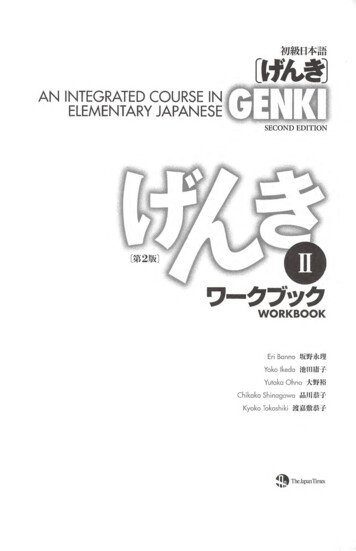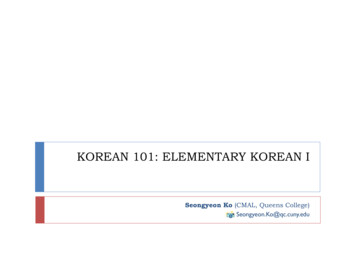
Transcription
KOREAN 101: ELEMENTARY KOREAN ISeongyeon Ko (CMAL, Queens College)Seongyeon.Ko@qc.cuny.edu
Greeting at the first time encounter 안녕하세요? 처음 뵙겠습니다. Nice to meet you.(lit. “I‟m meeting you forthe first time.”)Steve Wilson입니다. 2Hi/hello.(lit. “Are you in peace?”)I‟m Steve Wilson.KOREAN 101: ELEMENTARY KOREAN I8/27/2012
Course Introduction: syllabus & scheduleCredits: 4.0Class Hour / Classroom: MoWe 1:40PM - 3:30PM / Kiely Hall 321Course Website: [BlackBoard] – Details to be announced laterNote: To access the BlackBoard Course Management System for thefirst time, check this site /Instructor: Seongyeon Ko Office hours: 3Email: Seongyeon.Ko@qc.cuny.eduOffice: KG 210DPhone: 718-997-5562Tuesday & Thursday 1:40PM - 2:30PM or by appointmentKOREAN 101: ELEMENTARY KOREAN I8/27/2012
Course MaterialsTextbook (required): Integrated Korean: Beginning 1, SecondEdition, by Young-mee Cho, Hyo Sang Lee,Carol Schulz, Ho-min Sohn, Sung-ock Sohn. Univ.of Hawai„i Press, 2009. ISBN: 978-0-8248-3440-1.Workbook (required): Integrated Korean Workbook: Beginning 1,Second Edition, by Mee-Jeong Park, JoowonSuh, Mary Shin Kim, Sang-Suk Oh, Hangtae Cho.Univ. of Hawai„i Press, 2009. ISBN: 978-0-82483450.Audio files: 4streamable/downloadable athttp://kleartextbook.com/?cat 16KOREAN 101: ELEMENTARY KOREAN I8/27/2012
Other ResourcesOn-line vocabulary memorization: http://www.quizlet.com/ [details to be announced later]Sogang Korean Program (http://korean.sogang.ac.kr/): Computer-based fun activities for learning Korean on-line.Lecture powerpoint slides and section materials accessible from the course website.English-Korean, Korean-English on-line dictionary: http://endic.naver.com/Korean multimedia dictionary 5developed by Hyo Sang Lee and Aenglan Kim at Indiana U.http://www.indiana.edu/ koreanrs/kordic.htmlKOREAN 101: ELEMENTARY KOREAN I8/27/2012
Course Description and Objectives:Designed for students who have had no or very littleknowledge of KoreanCourse objective: All four basic skills (listening, speaking, reading, and writing) aswell as the cultural context in which the language is usedCommunicative competence and accuracyClass structure a 20-to-30 minute lecturea 80-to-90 minute drill section 6Drill sections taught entirely in KoreanSpend at least two to three hours to be prepared for every drillsection by familiarizing yourself with new words and expressionsBEFORE the class.KOREAN 101: ELEMENTARY KOREAN I8/27/2012
Course requirements for final grading1.2.3.4.5.6.7.7Daily grade (attendance)Homework6 Quizzes2 Oral 5%15%KOREAN 101: ELEMENTARY KOREAN I8/27/2012
Daily GradeRegular class attendance and active participation are crucial tolanguage learning. Daily grade will be given as follows:10 points- nearly perfect preparation and participation9- very good preparation and participation8- good preparation7- some preparation, but not sufficient6- poorly prepared; no fluency5- no preparation0- absence 8Additional points will be deducted when 1) you are late or 2) you speakEnglish during the drill section.Absence will not be excused in any case, since it will seriously impairyour performance and you will need extra effort to catch up. However,the lowest 3 scores (including “0”) will be removed at the end of thesemester. Therefore, you may wisely use these spots for unforeseenillness or accidents that may prohibit you from attending classes.KOREAN 101: ELEMENTARY KOREAN I8/27/2012
HW & QuizHomework Assignment: Mostly from the Workbook, but may be assigned with additionalmaterialsDo your homework BEFORE coming to the classNo late submission (including submission at the end of class) will beaccepted.Quizzes: 95-10 minute quizAt the beginning of the first day class of a new lesson6 quizzes in totalNo make-up quizzes except for the case of illness or religiousholidaysThe lowest score will be excluded in the calculation of your finalgrade.KOREAN 101: ELEMENTARY KOREAN I8/27/2012
Oral test Two Oral Tests Oral Test 1 (Lessons 1-3) on 10/24/2012Oral Test 2 (Lessons 1-7) on 12/12/2012Detailed guidelines TBAEssay & Presentation 10Write an essay about yourself in more than 2 nicely-builtparagraphs in Korean and present it in class1st draft due: 11/26/2012 (right after the Thanksgiving recess)One-on-one meeting with the instructor for a revisionPresentation on 12/10/2012Detailed guidelines TBAKOREAN 101: ELEMENTARY KOREAN I8/27/2012
Written test Midterm Exam 10/24/2012Covers Lessons 1-3Final Exam Covers everything we will have learned throughout thesemester (Lessons 1-7)Will be scheduled on a day in the final examination period(December 14-21). 11The exact date and location is to be arranged.KOREAN 101: ELEMENTARY KOREAN I8/27/2012
Course Grade97-10093-9690-92A AA-77-7973-7670-72C CC-87-8983-8680-82B BB-67-6960-660-59D DF12KOREAN 101: ELEMENTARY KOREAN I8/27/2012
Course schedule Please see the handout for a tentative schedule.Regularly check the course website for notifications.13KOREAN 101: ELEMENTARY KOREAN I8/27/2012
CUNY Policy on Academic Integrity Academic dishonesty is prohibited in the City Universityof New York and is punishable by penalties, includingfailing grades, suspension, and expulsion as provided f.14KOREAN 101: ELEMENTARY KOREAN I8/27/2012
ADA Statement Students with disabilities needing academicaccommodation should:Register with and provide documentation to the Office ofSpecial Services for Students with Disabilities, Kiely 171;2) Bring a letter to the instructor indicating the need foraccommodation and what type.This should be done during the first week of class. Furtherinformation can be found athttp://qcpages.qc.edu/spsv/oss staff.html.1) 15KOREAN 101: ELEMENTARY KOREAN I8/27/2012
Use of Student Work All teacher education programs in New York Stateundergo periodic reviews by accreditation agencies andthe state education department. For these purposes,samples of students‟ work are made available to thoseprofessionals conducting the review. Student anonymity isassured under these circumstances. If you do not wish tohave your work made available for these purposes, pleaselet the professor know before the start of the secondclass.Your cooperation is greatly appreciated.16KOREAN 101: ELEMENTARY KOREAN I8/27/2012
What kind of language is Korean?Essential information on the linguistic features of Korean(Integrated Korean, pp. 1-13)17KOREAN 101: ELEMENTARY KOREAN I8/27/2012
Speakers Korean is spoken As a native language by 67 million Korean people living on theKorean peninsula 23 million N. Koreans44 million S. KoreansAs a heritage language by 5.6 million oversees Korean residents 2 million in China2 million in the US0.7 million in Japan0.5 million in the former Soviet Union As a foreign language by an ever-increasing number of nonKoreans worldwide18KOREAN 101: ELEMENTARY KOREAN I8/27/2012
DialectsNW (P’yŏng.an) dialectNE (Hamkyŏng) dialectCentral dialect1.2.3. 4.5.6.19Including Seoul Korean(Standard Korean) andCh’ungchŏng dialectSW (Chŏlla) dialectSE (Kyŏngsang) dialectCheju dialectKOREAN 101: ELEMENTARY KOREAN I8/27/2012
Relationship to other languages20KOREAN 101: ELEMENTARY KOREAN I8/27/2012
Relationship to other languages Korean shows remarkable similarities with Japanese Mostly structural, not lexical, similarities: similar grammar, differentvocabularyThey may or may not be a sister language to each other.Arguably, Korean is an “Altaic” language Other Altaic languages Tungusic (e.g., Manchu)Mongolic (e.g., Mongolian)Turkic (e.g., Turkish)Japanese?In terms of language family, Korean has nothing to do withChinese or Russian 21Chinese, a Sino-Tibetan languageRussian, a Slavic ( Indo-European) languageKOREAN 101: ELEMENTARY KOREAN I8/27/2012
Vocabulary Three components 22Native words/affixesSino-Korean wordsLoanwords35 percent60 percent5 percentKOREAN 101: ELEMENTARY KOREAN I8/27/2012
English ce AN 101: ELEMENTARY KOREAN ��스스트라이크택시텔레비전8/27/2012
Syntactic characteristics Word order Head-initial vs. head-final languageEnglishSVO (John loves Mary.)Preposition (at school) KoreanSOV (John Mary loves.)Postposition (school-at)Free word orderA pro-drop language A “situation-oriented” language in which contextuallyunderstood elements are normally omitted.EnglishHow are you?24KoreanAnnyŏnghaseyo? [안녕하세요?]KOREAN 101: ELEMENTARY KOREAN I8/27/2012
Macro-to-micro The universe is represented in the order of a set (macro)and its members (micro). Family name first, Given name last.Year first, day last.Larger first, smaller last (e.g., in address)Englishvs.Prof. Minsu KimAugust 27, 20121 P’il Street,Chung District, Seoul25KoreanKim Minsu kyosu2012-year 8-month 27-daySeoul Chung-district P’il-street 1KOREAN 101: ELEMENTARY KOREAN I8/27/2012
Honorific expressions Different forms of expressions and different speech levels areused depending on the person you are talking to as well as theperson you are talking about.EnglishSon:Father:Good night, Dad.Good night, John.KoreanSon:아버지, 안녕히 주무세요.abŏji, annyŏnghi chumuseyo.father peacefully sleep너도 잘 자라.nŏ do chal chara.you also well sleepFather:26KOREAN 101: ELEMENTARY KOREAN I8/27/2012
Address/reference terms To a social superior or an adult distant equal: An occupational title (the gender neutral honorific suffix –nim)Kim Minsu kyosu-(nim)Kim sŏnsaeng-(nim)Kyosu-nim Prof. Minsu KimTeacher KimProfessorAmong young colleagues or to an adult junior: a (full/given/family) name the gender-neutral noun ssiKim Minsu ssiMinsu ssiKim ssi 김민수 교수(님)김 선생(님)교수님김민수 씨민수 씨김씨Mr. Minsu KimMr. MinsuMr./Miss. Kim (warning!)To address or refer to someone who is very close to you butyounger than (or equal to) you in terms of age (e.g., a child or afriend of yours):(Kim) 아(address/reference)(address)(address)KOREAN 101: ELEMENTARY KOREAN I8/27/2012
Honorific and humble words Honorific words:Plain Honorificpap밥chinji진지„rice, esi-da계시다„stay‟Humble wordsPlain28Humblechu-da주다„give to a junior‟tŭri-da드리다„give to a senior‟po-da보다„see a junior‟pwep-ta뵙다„see a senior‟KOREAN 101: ELEMENTARY KOREAN I8/27/2012
Pronouns First person pronounsplainnauriSingular („I‟):Plural („we‟): vs.humblechŏ저chŏhŭi 저희vs.honorific나우리Second person pronounsSingular („you‟):Plural („you‟):plainnŏ나nŏhŭi 우리Use address/reference terms as second person pronouns:e.g., (Kim) sŏnsaeng-nim (김) 선생님 ‘you teacher (Kim)’29KOREAN 101: ELEMENTARY KOREAN I8/27/2012
Speech levels Six speech levels indicate the speaker‟s interpersonal relationship with theaddresseeExpressed by sentence-endingsE.g., Declarative (statement) sentence typeSpeech levelsSentence-endingsdeferential ite style-ŏyo/-ayo어요/아요먹어요blunt style [infrequent]-so/-o소/오먹소familiar style [infrequent]-ne네먹네intimate style-ŏ/-a어/아먹어plain style-ta/-da다먹다30KOREAN 101: ELEMENTARY KOREAN IExample: mŏk- ‘eat’8/27/2012
Sound pattern: consonantsConsonant pㅂtㄷch ㅈkㄱtensepp ㅃtt ㄸtch ㅉkk ㄲaspiratep‟ ㅍt‟ ㅌch‟ ㅊk‟ ess ㅆ32hㅎlㄹLiquidNasalThroatmㅁnㄴng ㅇKOREAN 101: ELEMENTARY KOREAN I8/27/2012
Three-way contrast in �33KOREAN 101: ELEMENTARY KOREAN I8/27/2012
Sound pattern: eight simple vowels34TonguepositionFrontBackShape of the ㅔŏㅓoㅗLowaeㅐaㅏKOREAN 101: ELEMENTARY KOREAN I8/27/2012
숙제 (due 8/29 Wednesday) Read IK (Integrated Korean) pp. 1-1335KOREAN 203: INTERMEDIATE KOREAN I8/27/2012
Aug 27, 2012 · Course Description and Objectives: Designed for students who have had no or very little knowledge of Korean Course objective: All four basic skills (listening, speaking, reading, and writing) as well as the cultural context in which the language is used Communicative competen
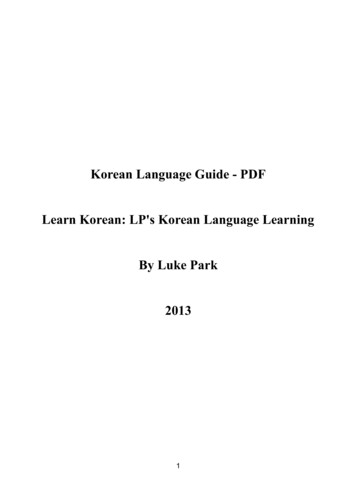
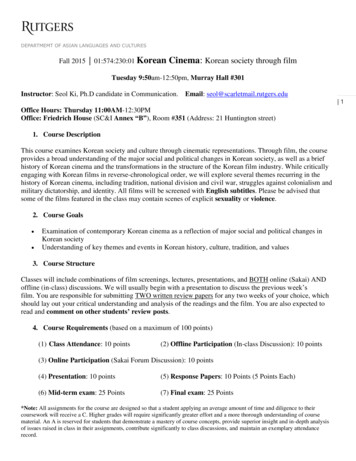

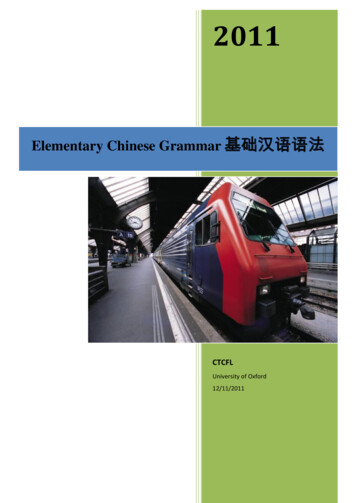
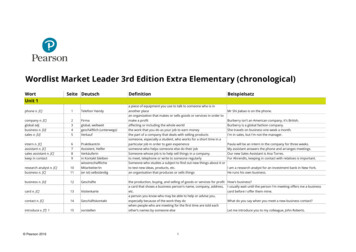
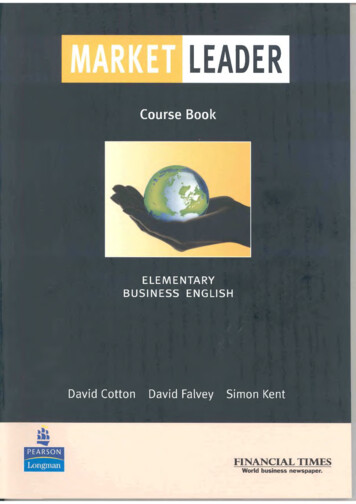
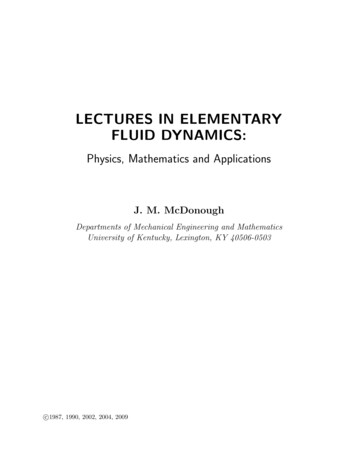
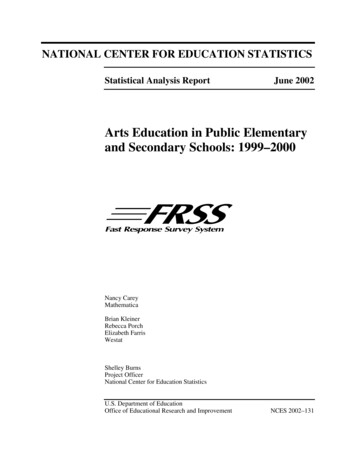
![Rubank elementary method : [for] flute or piccolo](/img/5/rubankelementary-flute.jpg)
